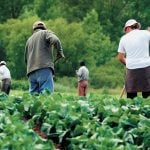An unexpected accident has led to a discovery that could lead to drought-resistant alfalfa.
Abdelali Hannoufa, an Agriculture Canada research scientist in London, Ont., has recently found a gene in the alfalfa plant that regulates its capacity to maintain water content.
The gene in question is called microRNA156 and is a master gene regulator.
“It functions by regulating a network of other genes, called down-stream genes, which control yield, stress tolerance and other factors,” he said.
Hannoufa, who specializes in functional genomics and metabolic engineering, said the initial research goal was to improve the nutritional quality of canola seed, and what he came up with was microRNA156.
Read Also

Alberta may eliminate marked fuel
Alberta may soon stop selling dyed gasoline and diesel.
It was initially discovered in arabidopsis in 2008 and was shown to improve the caratenoid contents of canola. However, he said it also delayed flowering, which is not useful in an oilseed like canola.
“But I realized that would be very useful for a forage crop like alfalfa because alfalfa prefers a bit of a delay in flowering,” he said.
“We found this gene delays flowering and actually allows farmers to delay their harvest time, and therefore they can increase the yield without affecting the quality.”
Hannoufa said flowering time could be managed and controlled with significant flexibility.
“We found this gene can be expressed at different levels,” he said.
“The higher the expression, the longer the delay, and in our experiments we found it goes from one day up to 60 days or more.”
MicroRNA156 improves yield while maintaining quality, but it also improves drought tolerance because the total biomass of root growth in the improved alfalfa under drought stress is double that of normal alfalfa.
More roots allow plants to produce more nodules.
“The more nodules, the more nitrogen fixation,” he said.
The discovery has the potential to be a game changer because the new alfalfa could be grown in unpredictable climate conditions and marginal soils.
The benefits mean savings for the producer.
“So it doesn’t have to compete with food crops like corn, canola or soybean,” he said. “It will also reduce the cost of production because if the plants are able to fix nitrogen, there is less need of applying fertilizers, fuel and manpower.”
Ongoing research of gene functions continues under greenhouse conditions in London as well as a second year of field trials in the United States.
Hannoufa said his initial research focus was not on drought when he discovered the gene.
However, most scientific discoveries were accidents.
“You are looking at something else and suddenly you run into it,” he said.
“In research, you think you are moving from A to Z, but in the process you may discover new things that may be more useful actually than the factors of your initial research. So you have to be open minded. A scientific discovery is a scientific discovery. You try to focus on your research objectives, but sometimes you don’t ignore other findings.”















